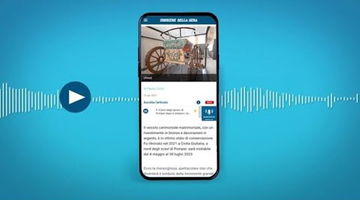
Bringing written text to life with text-to-speech (TTS) platforms sounds pretty straightforward. That is, it’s straightforward until you try to figure out which solution you need and how all the various options compare to one another. As it turns out, there are dozens of different TTS solutions that all sound similar, but in practice can offer very different user experiences.
Let’s explore the difference between ReadSpeaker and the standard screen readers you may have encountered before.
ReadSpeaker Vs. Screen Readers
What is a screen reader?
Screen readers convert text or Braille on a computer screen into spoken words that the user can listen to as they work. Screen readers—as the name implies—typically read everything on the screen, including browser tabs, button text, and other elements on the page. This level of assistance can be invaluable to blind or visually impaired users, as it allows them to independently navigate computer interfaces and make use of the full functionality of their devices without needing help from anyone else.
Two of the most popular screen readers are JAWS and NVDA, which both provide a voiceover of everything you might encounter in Microsoft Windows or Apple’s Mac OS environment. They also read Braille display elements, Chrome and Firefox browser tabs (check for compatibility if you use a different browser), document headings, and alt text of images within documents.
What is ReadSpeaker?
ReadSpeaker text-to-speech tools also convert written text to voice, but it does so with additional customization options that make the experience smoother for people who are not fully blind.
Whereas a blind person may need every single element on the screen read aloud, someone with a hint of visual impairment, dyslexia, or ADHD likely does not. They are able to see the screen, but for one reason or another—whether it’s due to dyslexia, ADHD, another learning challenge, or a preference for a different learning style—they prefer audio assistance when digesting digital content.
ReadSpeaker addresses this middle ground by providing users with a way to receive audio assistance where and when they need it. With a simple click on the selected text, users can hear high quality voices read text aloud within a web browser, a document, a learning management system (LMS), or on their phones.
Your choice of tool depends on your users.
ReadSpeaker users range from individuals who want a little help understanding the content in their documents and web browsers to schools, government organizations, and large companies that need to make sure all their online content is accessible for employees who may have visual impairments, dyslexia, or other problems deciphering text on screens.
In comparison, screen reader users usually have blindness or severe visual impairments.
If your use cases vary, you can use both.
ReadSpeaker’s TTS program can be used as a standalone solution or as a complement to a screen reader. Though it may seem redundant on the surface to offer both simultaneously, doing so can help you ensure a wide variety of users can understand and enjoy your content.
Let’s say you run a school district and you’re trying to make sure all your educational content is TTS-accessible within your school’s LMS. You may have students who fall anywhere within that diagram above, and perhaps some students who have multiple disabilities.
In that case, you might want to make both forms of assistive technology available to your students to make sure every base is covered.
On the other hand, perhaps you run a business and you don’t have any visually impaired employees—or if you do, they already receive special services or they have their own TTS solution they prefer. In that case, your goal may be to provide all users with a seamless working experience, regardless of their capabilities.
If so, ReadSpeaker is an excellent way to give your employees a way to use voice assistance when reading web pages and documents.
✓ Essential for people with visual impairments
✓ Enables users to navigate and interact with computer interfaces independently so they can utilize the full functionalities of their devices
✓ Built by default into mobile devices running Android and iOS
✓ Provides Braille support
✓ Has a broader audience, including those with reading difficulties or who prefer auditory learning in addition to individuals with visual impairments
✓ Does more than read content; ReadSpeaker also makes web content adaptable to the user, who can adjust the way they hear it and the way it appears on screen
✓ Offers more flexibility than screen readers in that it allows users to customize their listening experience
✓ Designed for both users and website owners/content creators who want to create a speech-enabled platform that doesn’t require the use of a screen reader
✓ Integrates into existing platforms and websites to enhance accessibility
✓ Enhances the user experience of a screen reader by offering more/better voices to choose from
ReadSpeaker excels at converting STEM content to voice.
Screen readers often struggle with STEM content—especially with math symbols and formatting. In contrast, ReadSpeaker is capable of handling advanced math concepts. Additionally, you can change the way ReadSpeaker’s voices sound and how they pronounce certain terms within our customizable pronunciation library.
Both can be used online or offline.
There are some screen readers that operate online in the cloud, but for the most part, you’ll probably come across screen readers that are already built into your operating system, or screen reader services you can purchase, download, and install.
Once you have the software set up, screen readers by their very definition will read anything that’s on your screen. This means you could be surfing the web, skimming through your downloaded files, working in an offline document, or using a proprietary LMS within a school system, and your screen reader will make sure you hear the text on each page, button, and file you open.
ReadSpeaker can also function on- or offline, provided you choose the correct integrations for the situation. That’s because some people don’t want to hear everything spoken aloud. In fact, that kind of distraction can make ADHD and similar disorders even more difficult to work with.
Instead, we provide a number of tools that will work when and where you want them—and nowhere you don’t. Try webReader for web pages, docReader for documents, and TextAid for pretty much everything else—including your phone!
Interested in learning more about ReadSpeaker?
Give us a shout here
Fredrik Larsson is the Co-founder and Chief Architect of ReadSpeaker. Fredrik graduated from Uppsala University in Sweden, with a master in engineering physics and Tekn Lic. in computer systems and has 30+ years of experience in technical development, international standardisation and accessibility. With a deep passion for innovation and a strong technical background, Fredrik has been instrumental in developing and advancing ReadSpeaker's cutting-edge TTS solutions. Under his leadership, the company has significantly improved digital accessibility and user experiences worldwide. His expertise and vision continue to drive ReadSpeaker's growth and success in the rapidly evolving tech landscape.


